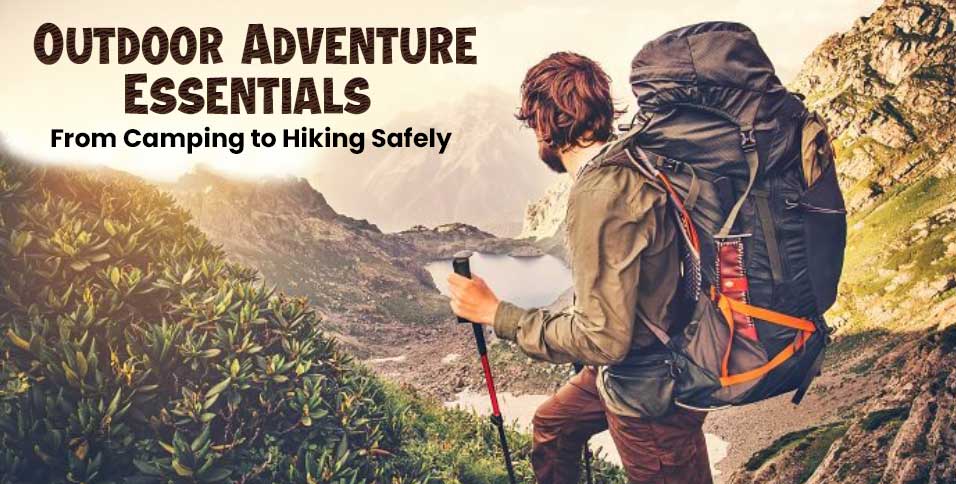Embarking on outdoor adventures, whether camping in the wilderness or hiking through rugged terrain, offers exhilarating experiences and opportunities for exploration. However, venturing into the great outdoors also comes with inherent risks and challenges that must be addressed to ensure a safe and enjoyable journey. In this comprehensive guide, we’ll explore the essential gear, tips, and techniques for outdoor adventure enthusiasts, from camping essentials to hiking safely in diverse environments. And yes, we’ll also discuss the importance of self-defense knives as part of your outdoor gear arsenal, providing an added layer of security in remote wilderness settings.
1. Planning Your Outdoor Adventure
Before setting out on your outdoor adventure, proper planning is essential to ensure a safe and successful trip. Research your chosen destination, including weather conditions, terrain features, and potential hazards such as wildlife encounters or natural disasters. Develop a detailed itinerary, including planned routes, camping locations, and emergency contact information. Consider factors such as transportation, permits, and equipment rental or purchase to ensure you’re fully prepared for your adventure.
2. Essential Gear for Camping
When camping in the great outdoors, having the right gear can make all the difference in your comfort and safety. Essential camping gear includes a durable tent or shelter, sleeping bag, sleeping pad or mattress, cooking equipment, food and water supplies, navigation tools, and appropriate clothing for varying weather conditions, and hunting tools including Night vision optics. Additionally, consider packing items such as a first aid kit, multi-tool, flashlight or headlamp, fire-starting supplies, and insect repellent to address common camping needs and emergencies.
3. Hiking Safely: Tips and Techniques
Hiking is a popular outdoor activity that allows adventurers to explore scenic landscapes and connect with nature. However, hiking safely requires proper preparation, awareness, and respect for the environment. Before hitting the trail, familiarize yourself with the route, trail conditions, and potential hazards such as steep terrain, slippery surfaces, or wildlife encounters. Pack essential hiking gear, including appropriate footwear, clothing layers, navigation tools, water, snacks, and a first aid kit. Stay on marked trails, heed signage and warnings, and be mindful of your physical limitations and abilities to avoid accidents and injuries.
4. Self-Defense Knives: Enhancing Outdoor Safety
In remote wilderness settings, having a self-defense knife as part of your outdoor gear arsenal can provide an added layer of security and peace of mind. Self-defense knives are compact, lightweight tools designed for personal protection in emergency situations. Look for a knife with a durable blade, secure locking mechanism, and ergonomic handle for ease of use and reliability in outdoor environments. While the primary purpose of a self-defense knife is to deter potential threats and create a window of opportunity for escape, it can also serve practical purposes such as cutting rope, preparing food, or building shelters in survival situations.
5. Safety Considerations and Emergency Preparedness
No outdoor adventure is without risks, so it’s essential to prioritize safety and be prepared for emergencies. Before heading into the wilderness, familiarize yourself with basic wilderness first aid techniques and CPR, and pack a comprehensive first aid kit with essential supplies for treating injuries and illnesses. Communicate your plans and expected return times with a trusted friend or family member, and carry communication devices such as a cell phone, satellite phone, or two-way radio for emergency communication. Additionally, consider carrying signaling devices such as a whistle, mirror, or personal locator beacon (PLB) to alert rescuers in case of emergencies.
6. Leave No Trace Principles
Responsible outdoor recreation involves practicing Leave No Trace principles to minimize your impact on the environment and preserve natural resources for future generations. Follow guidelines such as packing out all trash and waste, staying on designated trails, respecting wildlife and their habitats, minimizing campfire impacts, and respecting other visitors and their experiences. By practicing Leave No Trace ethics, you can help protect the wilderness and ensure that it remains pristine and accessible for all outdoor enthusiasts to enjoy.
Conclusion:
Outdoor adventures offer unparalleled opportunities for exploration, adventure, and connection with nature. By properly planning your trip, packing essential gear, hiking safely, incorporating self-defense knives into your outdoor gear arsenal, prioritizing safety and emergency preparedness, and practicing Leave No Trace principles, you can enjoy a safe and rewarding outdoor experience. Whether camping in the wilderness or hiking through rugged terrain, remember to respect the environment, prioritize safety, and embrace the spirit of adventure as you embark on your outdoor journey.
Also Read: Unlocking Adventure: The Role of Electric Adults EBikes in Outdoor Exploration
















